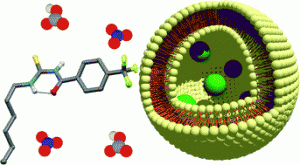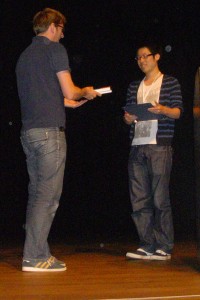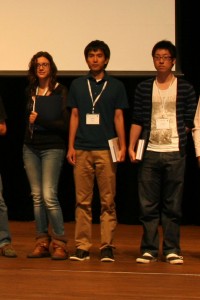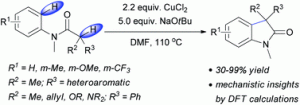During July, August and September, the following articles were the Top Ten most accessed:
Synthesis of azetidines and pyrrolidines via iodocyclisation of homoallyl amines and exploration of activity in a zebrafish embryo assay
Antonio Feula, Sundeep S. Dhillon, Rama Byravan, Mandeep Sangha, Ronald Ebanks, Mariwan A. Hama Salih, Neil Spencer, Louise Male, Istvan Magyary, Wei-Ping Deng, Ferenc Müller and John S. Fossey
Org. Biomol. Chem., 2013, 11, 5083-5093
DOI: 10.1039/c3ob41007b
Electrophilicity: the “dark-side” of indole chemistry
Marco Bandini
Org. Biomol. Chem., 2013, 11, 5206-5212
DOI: 10.1039/c3ob40735g
Transition-metal-catalyzed additions of C–H bonds to C–X (X = N, O) multiple bonds via C–H bond activation
Guobing Yan, Xiangmei Wu and Minghua Yang
Org. Biomol. Chem., 2013, 11, 5558-5578
DOI: 10.1039/c3ob40652k
Synthetic applications of photoredox catalysis with visible light
Yumeng Xi, Hong Yi and Aiwen Lei
Org. Biomol. Chem., 2013,11, 2387-2403
DOI: 10.1039/C3OB40137E
Bioorthogonal labelling of biomolecules: new functional handles and ligation methods
Marjoke F. Debets, Jan C. M. van Hest and Floris P. J. T. Rutjes
Org. Biomol. Chem., 2013,11, 6439-6455
DOI: 10.1039/C3OB41329B
DABCO-promoted synthesis of pyrazoles from tosylhydrazones and nitroalkenes
Meng Tang, Wen Zhang and Yuanfang Kong
Org. Biomol. Chem., 2013,11, 6250-6254
DOI: 10.1039/C3OB41435C
Organocatalytic asymmetric synthesis of ß3-amino acid derivatives
Sun Min Kim and Jung Woon Yang
Org. Biomol. Chem., 2013, 11, 4737-4749
DOI: 10.1039/c3ob40917a
The first asymmetric total synthesis of (+)-coriandrone A and B
Wenjing Wang, Jijun Xue, Tian Tian, Yingdong Jiao and Ying Li
Org. Biomol. Chem., 2013,11, 6686-6690
DOI: 10.1039/C3OB41497C
Design and biological characterization of hybrid compounds of curcumin and thalidomide for multiple myeloma
Kai Liu, Datong Zhang, Jeremy Chojnacki, Yuhong Du, Haian Fu, Steven Grant and Shijun Zhang
Org. Biomol. Chem., 2013,11, 4757-4763
DOI: 10.1039/C3OB40595H
Pd(0)-catalyzed benzylic arylation–oxidation of 4-methylquinazolines via sp3 C–H activation under air conditions
Dan Zhao, Min-Xue Zhu, Yue Wang, Qi Shen and Jian-Xin Li
Org. Biomol. Chem., 2013,11, 6246-6249
DOI: 10.1039/C3OB41488D
If you have any thoughts or comments on any of these articles, please post these below.
Fancy submitting an article to Organic & Biomolecular Chemistry? Why not submit to us today!
Comments Off on Q3 Top Ten most accessed Organic & Biomolecular Chemistry articles



![Efficient and regioselective nickel-catalyzed [2 + 2 + 2] cyclotrimerization of ynoates and related alkynes](http://pubs.rsc.org/services/images/RSCpubs.ePlatform.Service.FreeContent.ImageService.svc/ImageService/image/GA?id=C3OB41872C)




























